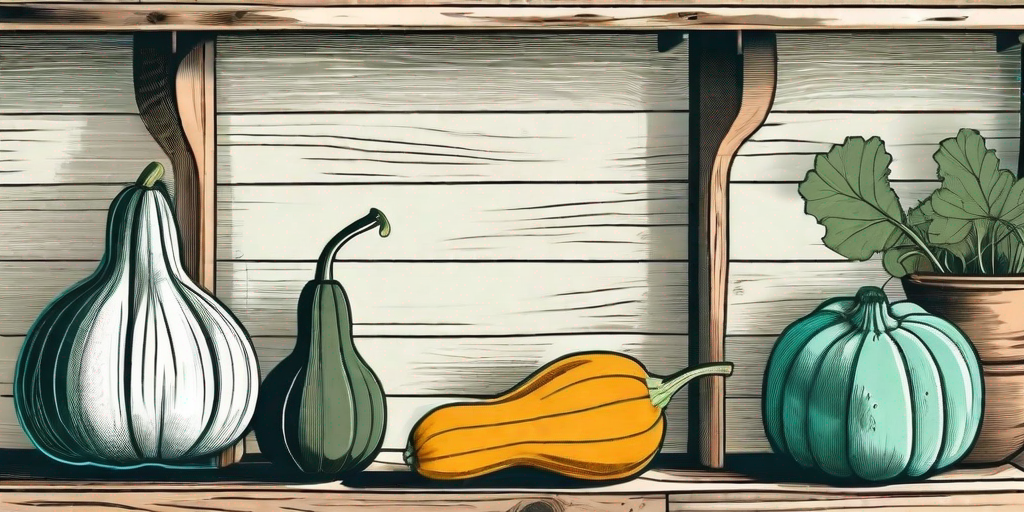
Ah, the humble squash. A staple in many a kitchen, this versatile gourd is a favorite for its rich flavor and hearty texture. But how do you keep your squash fresh for as long as possible? That's a question that has plagued many a home cook. But fear not, dear reader, for we have the answers you seek. So sit back, relax, and let's dive into the wonderful world of squash preservation.
Understanding Squash
The Anatomy of a Squash
Before we delve into the nitty-gritty of squash preservation, it's important to understand what makes a squash, well, a squash. Squashes are part of the gourd family, which also includes pumpkins and cucumbers. They have a thick, hard exterior and a soft, fleshy interior filled with seeds. This unique structure is what gives squash its long shelf life, but it also presents unique challenges when it comes to storage.
One of the key factors in squash preservation is the rind. This tough outer layer acts as a natural barrier, protecting the delicate flesh inside from the harsh elements. However, if the rind is damaged, it can significantly reduce the squash's shelf life. So remember, handle your squash with care!
Types of Squash
There are many different types of squash, each with its own unique characteristics. Some of the most common types include butternut squash, acorn squash, spaghetti squash, and pumpkin. While these squashes may look and taste different, they all share one thing in common: they're all delicious!
But when it comes to shelf life, not all squashes are created equal. Some types of squash, like butternut and acorn, have a longer shelf life than others. This is due to their thicker rinds, which provide better protection against spoilage. So if you're looking for a squash that will last, these are your best bets.
Storing Your Squash
Choosing the Right Environment
When it comes to storing squash, the environment is key. Squashes prefer a cool, dry, well-ventilated environment. The ideal storage temperature is between 50 and 60 degrees Fahrenheit. Any colder and the squash could freeze, any warmer and it could start to rot.
Humidity is another important factor to consider. Too much humidity can cause the squash to mold, while too little can cause it to dry out. The ideal humidity level for squash storage is between 50 and 70 percent.
Proper Storage Techniques
Now that you've found the perfect environment for your squash, it's time to talk about storage techniques. The first rule of squash storage is to never store your squash in a plastic bag. Plastic bags trap moisture, which can lead to rot. Instead, store your squash in a cool, dry place where it can breathe.
Another important tip is to always store your squash whole. Cutting a squash exposes the flesh, which can speed up the spoiling process. So resist the urge to prep your squash ahead of time and leave it whole until you're ready to use it.
How to Tell if Your Squash is Still Good
Visual Inspection
One of the easiest ways to tell if your squash is still good is to give it a good once-over. Look for any signs of mold, soft spots, or discoloration. If your squash has any of these, it's time to toss it.
Another thing to look for is the condition of the rind. If the rind is hard and intact, your squash is likely still good. But if the rind is soft or damaged, it's a sign that your squash has seen better days.
The Sniff Test
When in doubt, give your squash a sniff. Fresh squash has a mild, slightly sweet scent. If your squash smells off or has a strong, unpleasant odor, it's a sure sign that it's past its prime.
Remember, when it comes to squash, it's better to be safe than sorry. If you're unsure whether your squash is still good, it's best to err on the side of caution and toss it.
FAQs
How long does squash last?
The shelf life of squash depends on a variety of factors, including the type of squash, the storage conditions, and whether the squash has been cut. On average, whole squash can last between 1 to 3 months when stored properly. Cut squash, on the other hand, will only last about a week in the refrigerator.
Can I freeze squash?
Absolutely! Freezing is a great way to extend the shelf life of your squash. Just make sure to blanch it first to preserve its color and texture. Once blanched, you can freeze your squash for up to a year.
What's the best way to store cut squash?
If you've cut into your squash but aren't ready to use it all, the best way to store it is in the refrigerator. Wrap the cut squash tightly in plastic wrap or place it in an airtight container. It should last about a week this way.
Conclusion
And there you have it, folks! The definitive guide to keeping your gourds fresh. With these tips and tricks, you'll be able to enjoy your favorite squash dishes all year round. So go forth, and may your squash always be fresh and your meals always be delicious!











